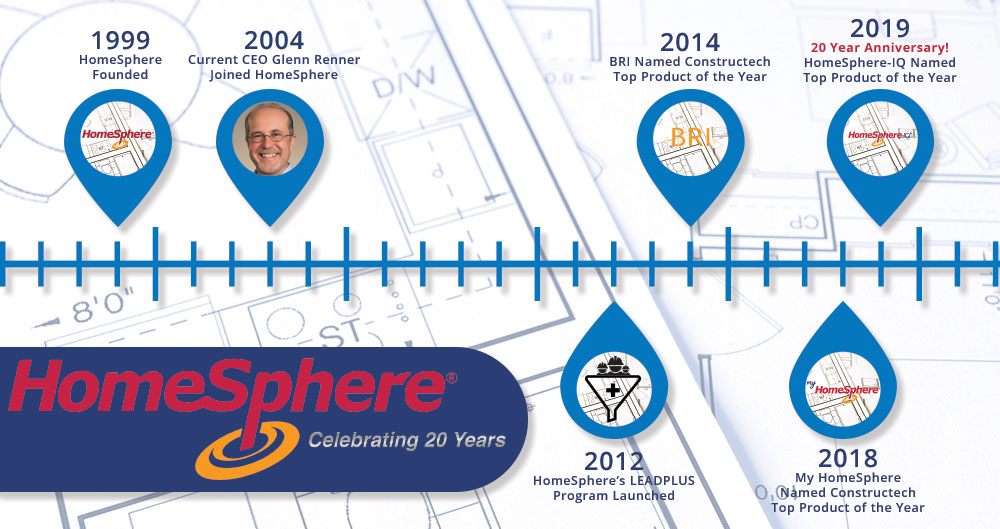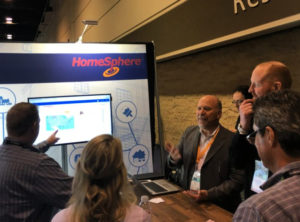HomeSphere Celebrates 20 Years in Residential Construction
July 23, 2019

Twenty years ago in July, HomeSphere began with a vision to bring technology to the residential construction industry. Now, 20 years later, we’re still innovating and transforming the way builders and manufacturers work together.
And we can’t think of a better anniversary present than being named to Constructech’s top 10 construction tech companies of 2019. The honor shows who we are as a company, what we value and where we want to go.
And it’s our team of partners and employees who make us the company we are.
Today, we’re partnered with more than 2,600 talented home builders and more than 80 of the top manufacturing brands, representing a brand catalog of more than 1,500 products. We’re all working together to bring transparency to the supply chain and promote valuable relationships across the industry.
 In 2018 alone, our builder partners completed 250,000 closings — representing 20 percent of the residential construction market — which included the use of thousands of building products from our manufacturer partners.
In 2018 alone, our builder partners completed 250,000 closings — representing 20 percent of the residential construction market — which included the use of thousands of building products from our manufacturer partners.
Internally, we’re proud to say we still employ team members who go back more than 15 years with HomeSphere. You’ll hear from them in this article.
And in our pursuit of bringing technology to construction, we’ve released two award-winning software platforms, My HomeSphere™ and HomeSphere-IQ™, in the last two years alone.
So, as long as we’re counting, we’ve won two top tech company awards, two Colorado business awards and two top product awards. And that’s just been in our “build and transform” phase — not bad for three years. And with our outstanding team, we know there’ll be more to come.
We’ve also expanded both our product offerings, and our team across departments.
But we wouldn’t have gotten here without our roots, and much to the chagrin of many Coloradoans, they start in Texas with a company called Builder Resources Inc.
The early days of HomeSphere
Located in Dallas, Builder Resources Inc. coordinated rebates between builders and manufacturers, and had the distinction of employing HomeSphere’s current longest-serving employee, Letty Gutierrez, who started with the company in 1997 as a receptionist.
 During this same time, Jim Waldrop was creating a vision for his own company, HomeSphere. He wanted to connect the construction industry with new technology after spending years working within residential construction, including a decade spent with Pulte Homes in various operational and executive positions.
During this same time, Jim Waldrop was creating a vision for his own company, HomeSphere. He wanted to connect the construction industry with new technology after spending years working within residential construction, including a decade spent with Pulte Homes in various operational and executive positions.
In 1999, the same year he founded HomeSphere, Waldrop purchased Builder Resources Inc., moving it from Texas to Colorado. With Builder Resources Inc., HomeSphere gained relationships with manufacturers — including York, ICP, GE Industrial, Yale and Rheem — who are still our partners to this day.
Gutierrez also made the move and began working directly with builders. “When I started, we were processing rebates on floppy disks,” she said.
But soon, HomeSphere launched its Builder Rebates and Incentives program, the building industry’s first web-based marketplace platform for builders and manufacturers.
“That was exciting to be part of,” Gutierrez said. “We were so advanced in technology when BRI was created.”
But it wasn’t just with technology that HomeSphere worked to differentiate itself. In 2002, John Poe answered a newspaper ad looking for a regional market specialist, and he’s now the longest-serving specialist here.
HomeSphere’s market specialists were created to work with both builders and manufacturers to establish close relationships between key players in the industry.
 “We separated ourselves by being the only ones with feet on the street,” Poe said.
“We separated ourselves by being the only ones with feet on the street,” Poe said.
During the early years, the company also acquired BuildSoft Enterprise and Builder 360, which brought two other HomeSphere old-timers, Stacey Thorne and Shawn Mathis, to the company in 2003 and 2004, respectively. Thorne was originally hired to manage customer service for BuildSoft, while Mathis worked with Builder 360 on data migration and custom access applications.
It’d be tempting to assign specific job titles to everyone in the early stages, but the reality was that everyone did everything. “It was like a small family,” Mathis said.
Glenn Renner, HomeSphere’s current CEO came to the company in 2004 after 17 years with Sherwin Williams and remembers well the close-knit atmosphere. “There were about 30 to 40 people in our [first] office and only Jim [Waldrop] and I had our own offices,” he said. “My desk was part of a conference table placed on two filing cabinets.”
But the close quarters didn’t deter anyone. “It was an entrepreneurial time,” Renner said.
At that time, he said, the focus of the company was more on home builder software and enterprise resource planning than BRI, but as the company moved into its middle years, that would change and HomeSphere would go from being “a house of brands to a branded house.”
HomeSphere matures
In the mid-aughts, BuildSoft and Builder 360 were sold to focus on our marketplace platform, BRI. By 2010, more than 1,000 builders were signed up with the program, which helped to manage rebates between builders and manufacturers.
During this time, we built a partner base with trusted national brands like GE Appliances, Lennox, Electrolux, Kwikset and more — all brands that are still with us today.
In 2008, HomeSphere began laying the foundation for its lead generation platform via the acquisition of BestContractors.com, a start-up which connected homeowners to licensed and insured contractors. Liz Polson, HomeSphere’s marketing director, joined the company by way of this acquisition while early in her marketing career.
“From day one, it was clear to me that HomeSphere was not only leading the conversation on residential construction technology but following through on that conversation with a unique and long-term vision for the industry,” she said. “I was excited to become part of the family and grow with HomeSphere.”
 But it was also during this time that the subprime mortgage and housing crisis hit the country, and everyone doing business in the construction industry. “Those were really dark days,” Renner said, but, “getting through it really was a proud moment.”
But it was also during this time that the subprime mortgage and housing crisis hit the country, and everyone doing business in the construction industry. “Those were really dark days,” Renner said, but, “getting through it really was a proud moment.”
Renner credits the camaraderie and fight of HomeSphere’s employees with steering the company through. Renner calls this phase the “survival mode” and much like the first phase, “everyone did what it took,” he said.
“You had to wear multiple hats,” Mathis said, “you stuck through it. You did your job, and moreso.”
And with the continued support of builders and manufacturers who partnered with HomeSphere, the company did stick through it to emerge with a clear direction: follow the digital age.
HomeSphere’s platform growth mode
In 2012, HomeSphere launched our LEADPLUS program to connect interested builders with our partner manufacturers. It was another step toward showing our partners that we had more to offer than rebate management.
In 2014, Constructech named BRI a top product of the year, and the platform continued to be updated as HomeSphere focused on building the best B2B platform for both builders and manufacturers.

These goals eventually led to the development of My HomeSphere and HomeSphere-IQ.
As Renner put it, My HomeSphere became “the first step in the development of a technology foundation that will change the way the construction industry uses data and enables us to be more innovative and responsive to industry needs.”
The platform allows home builders to manage their rebates, analyze and plan for future developments and discover new products. It also provides builders with easy access to our regional market specialists who can help them establish relationships with manufacturers and trades.
The platform won Constructech’s top products for 2018.
Then came HomeSphere-IQ, our platform for building product manufacturers. As noted in our blog post on the platform’s own Constructech recognition for 2019 top products, the platform completed the HomeSphere marketplace connection, giving manufacturers the tools they need to better connect with and support HomeSphere’s rapidly growing community of residential new home builders.
And even as regular updates are made to both platforms, we continue to look to the future.
Where does HomeSphere go from here?
It’s no secret that it’s our intention to digitize the U.S. home inventory, home by home, product by product, throughout a home’s life cycle. And as a partner to both builders and manufacturers, we are in the unique position to see all sides of the supply chain.
 As it is now, Renner said, the construction industry is dealing with a fragmented supply chain, and digitizing it means manufacturers will have clarity on where their products end up, distributors and dealers will better prepare for stock needed and home builders will accurately and efficiently bid projects. Simply put, it would be a game-changer.
As it is now, Renner said, the construction industry is dealing with a fragmented supply chain, and digitizing it means manufacturers will have clarity on where their products end up, distributors and dealers will better prepare for stock needed and home builders will accurately and efficiently bid projects. Simply put, it would be a game-changer.
We also know our partners are hurting from labor shortages, and we want to be part of the solution for that too.
“At the end of the day, building someone’s house is incredibly aspirational,” Renner said. We’re proud to be a part of an industry that literally puts the roof over our heads and we’re constantly in awe of the innovations of our builder and manufacturer partners.
We just want to do what we can for them, and for our own team. And in another 20 years, we look forward to filling you in on where we’re at in 2039.
Learn more about becoming a HomeSphere builder or manufacturing partner.






